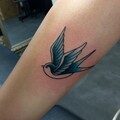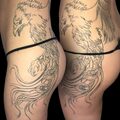Tattoo aftercare is vital to the healing process, as it has a significant impact on the final result of the tattoo, the vibrancy of the colour and the health of the skin. There are several types of aftercare, based on different principles and offering different benefits. In the following articles and in the following articles, I will describe the most common tattoo after-treatment methods, starting with the traditional foil method.
Aftercare with folpack foil
(Szabina's aftercare below)
What you will need during the care, available from any pharmacy:
- cream for aftercare: Bepanthen cream (wetter consistency)/ointment (greaser consistency)
- antibacterial soap (unscented, dye-free)
- Octenisept spray
- medical adhesive tape
- folpack foil
- body lotion
- After the tattoo is done, the tattoo artist will clean the skin and cover the fresh tattoo with folpack foil. This will protect the open wound from bacteria, dirt and contact with clothing. From now on, you will have to repeat this process as described.
- While the tattoo is fresh, it is important to keep it clean so that nothing gets into it that could cause infection. It is important to always wash your hands before touching it!
- Remove the foil a few hours after the tattoo and throw it away!
- Wash the tattoo with antibacterial soap, without soaking. Rinse thoroughly, first with lukewarm and then cold water, to help close the pores of the skin.
- Gently blot with a paper towel or just let it dry. Do not wipe with a towel!
- Spray it evenly with Octenisept spray and let it dry.
- Apply a thin layer of Bepanthen and place a clean foil pack on top. Make sure that the inside of the foil is in contact with the tattoo.
The next day:
When it is no longer bleeding or oozing, it is still important to keep the wound clean. Wash it with soap, rinse thoroughly with water, dry it with a paper towel and spray it with Octenisept spray. When it has dried, apply a thin layer of Bepanthen and cover it with a clean plastic foil. Make sure that the inside of the foil is in contact with the tattoo. Change this bandage 2-3 times during the day, so repeat the steps in point 8.
On the third day:
The tattoo will no longer oozing, so the wrap will no longer be needed, instead leave it open so that your skin can breathe. Apply a thin layer of Bepanthen 2-3 times during the day, the goal is to hydrate.
In about 7-10 days, the tattoo will start to peel, which is an unpleasant feeling because it itches. At this time, try not to scratch it with your nails, no matter how much you want to; because scratching vigorously can tear the wound and the pattern will be incomplete. Try stroking, patting, or scratching through clothing. You can also use a gentle skin scrub on the surface, and calendula cream can be a good solution to relieve itching.
After the 10th day:
When your tattoo has completely peeled off, you will not need Bepanthen, but until its surface is shiny and has not completely healed, moisturize it with the body lotion you used to pre-treat the surface.
What NOT to do:
- do not use any other cream than the ones prescribed
- do not scrape or scratch, the dead skin layer will fall off on its own, just be patient!
- do not soak it, you can shower, you should even wash it, but do not soak it!
- sunbathe, go to a solarium, use tanning cream; if you absolutely must sunbathe, cover it up!
- any bathing, sauna use is prohibited for 2-3 weeks
- do not use sunscreen while the tattoo is fresh
Once it is completely healed, use sunscreen when you are in the sun for a longer period of time to protect the colors and keep them vibrant for a long time!






